Statistical Effects of Proposed NBA Rule Changes
Dean Oliver
Journal of Basketball Studies
http://www.rawbw.com/~deano/index.html
23 July, 2001
Introduction
The NBA has voted to institute some drastic rule changes into effect for the 2001-2002 season. This package of rule changes, principally
·
Scrapping illegal defense rules
·
Enforcing more stringently the defensive 3-second rule
·
Giving teams 8 seconds instead of 10 to bring the ball past midcourt, and
·
Redefining incidental contact to cut down on touch fouls
represents the league’s most recent and most extreme attempt to repair what’s wrong with the game. These rule changes, though nearly unanimously adopted by the league, are not meeting with unanimous agreement among league followers, especially the elimination of the illegal defense rules. Players who have made their living beating defenders off one-on-one sets are particularly fearful that their impact will be reduced with zones allowed. With no increase in the shot clock, there is fear that offenses will be forced into a lot of rushed shots at the end of the clock. It’s not even clear that these changes will address what is really wrong with the game. What is wrong with the game? And will these changes start to address it?
What is Wrong with the NBA?
Everything from sex (DeShawn Stevenson) to drugs (Shawn Kemp) to rock-n-roll (too much loud music during timeouts), according to some people. And Michael Jordan is gone – for now.
What bugs the league and the fans – those who accept that society’s ills cannot be completely shut out of the great game – is the style of the NBA play. It’s slow and, despite the Charles Barkley rule (or Mark Jackson rule) forbidding extensive post-up time, it grinds to predictable one-on-one matchups far too often. This has happened because some smart coaches have recognized ways of exploiting the rules to help their teams win. Then, coaches who aren’t as smart simply imitate the ones who figured it out first.
Before you go and blame the league style on players with bad attitudes, or players who haven’t gone to college, or players who only want to dunk or shoot threes – though these may be true –the league can’t do anything about these things. The league is seemingly begging kids to go to college and not join the NBA Draft, but persuasion the only power it really has. What the league can do is make rule changes that influence coaching strategy, which then can change the style of play and the style of players in the NBA.
In no particular order, the coaching strategies that have had the biggest effects on creating the prodding NBA style are described below.
- Coaches have been telling their kids to rotate quickly on defense for decades; in the last ten years, the kids have learned to do it pretty well.
This is just good coaching on any level, teaching players to rotate and move their feet defensively. After 50 years of hearing it, kids are moving their feet on defense better than they ever have. It is much more cool now to be known as a good defender than it was 20 years ago when it was a euphemism for "guy who can’t shoot".
This renaissance in defense began in the late 1980’s to early 1990’s, perhaps with the Detroit Pistons who finally slowed down the Showtime Lakers, perhaps with the Pat Riley Knicks who rotated incessantly, or perhaps with Michael Jordan and Scottie Pippen stifling opposing scorers on their way to multiple NBA titles. Quickness in defenders became a priority in the 1990’s, especially in the NBA where you couldn’t hide a slow defender behind a zone defense. Slow guys who could shoot the ball didn’t necessarily get drafted, while "athletic leapers with tremendous potential" became the hot commodities, even if they never would be able to shoot the ball.
Better defense has both slowed the league and reduced the scoring efficiency. Teams need longer to get a good shot and, when they get it, it’s not as good as it once was. Figure 1 graphically demonstrates these things. Pace, represented in possessions per game per team, has slowed 6-8% in the last 10 years. Scoring efficiency, represented by points scored per 100 possessions (labeled as "Rating"), has come down 4-6%. That’s why points scored are down 12-14%.
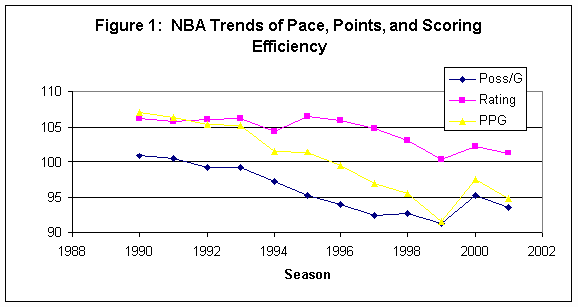
- Coaches, led apparently by Pat Riley when he joined New York, forwarded the commandment – "No layups allowed" – and it is now followed religiously.
At the latter end of the 1980’s, word went around the NBA that the way to beat the Lakers was to beat them up, to "play them physically". Laker Coach Pat Riley resented it at the time and, when his team got beat in the Finals by a Detroit Pistons team employing the strategy, Riley remembered. After a year watching the NBA from the broadcast booth (and losing pop-a-shot competitions to Bob Costas), Riley came back to coach the New York Knicks in the 1991-1992 season. He came back determined to get vengeance.
Riley’s first season with the Knicks inspired a 12 game improvement in the team. Even more eye-catching to other coaches was what happened in the playoffs. The Knicks got nowhere close to beating the Bulls in 1991 in their first round series, losing 3-0. In 1992, under Riley’s changes (to be discussed), the Knicks beat the Pistons in the first round playing better bad-boy-ball than the Bad Boys themselves. They followed it up with a physical 7-game series loss to the eventual champion Bulls, battering the heroic Michael Jordan in the process.
Riley improved the Knicks through defense. He taught them to rotate quickly and he taught them to allow nothing easy. Riley saw the league getting more physical and he decided to push it. He espoused the infamous phrase, "No layups allowed." Numerically, the Knicks’ improvement from ’91 to ’92 was 1 point offensive and 3 points defensive; the Knicks’ offensive rating (points per 100 possessions) went from 105.4 to 106.4 and its defensive rating went from 105.6 to 102.3. They did it by fouling an extra 2 times per game and sending opponents to the line an extra 3 times per game. Their opponents shooting percentage went from 47.6% to 45.8%. Their opponents started taking more threes because they were getting beat up or double-teamed down low. Riley figured that he wouldn’t get beat with jump shots.
And the league learned. The league had been shooting more three-pointers every year for a while, but it jumped in 1993 and took a huge leap in 1995 (Figure 2). The big leap was due to the league's decision to move the three-point line in, a reaction to the Riley-style brutality in the post. The rule lasted through the 1997 season until the league decided that three-pointers were getting to be too prominent. After an initial bump up in 1995, the league shooting percentage from 2-point land actually spiraled down, one of the most disturbing aspects of the analysis. Figure 3 shows how 2-point FG% was steady until 1995, but has been plummeting since. The league’s effective field goal percentage, which adjusts for the additional point gained by making a three-pointer, has been in decline as well even though three-point percentages remain high.
This decline could be the lack of mid-range jump shooters that we’ve heard about, but it appears to be the "No layups" rule. Recall back in the 1980’s when teams would often have a guy like a Mark West or a Steve Johnson or a Buck Williams who just knew how to finish off after an offensive rebound. Remember when Dennis Rodman used to shoot nearly 60% doing the same thing. Then teams learned that he didn’t shoot foul shots very well and sent him to the line. Then he turned into a complete freak, but we digress. In the ‘91-92 season, Rodman shot 54% from the field, taking only 140 shots from the foul line. In the next season, Rodman shot 23 more foul shots (at 53%) in 1000 fewer minutes and his field goal percentage plummeted to 43%. Rodman was an extreme (there’s an understatement), but the league’s leading field goal percentage shooters showed a similar pattern. Figure 4 shows the average field goal percentage of the top 10 league shooters since 1990. Whereas the league’s top 10 used to shoot an average of 57% from the field, it now struggles to shoot 52%. In 2001, only the league’s leading shooter, Shaquille O’Neal, shot 57%. Figure 5 shows how fewer and fewer players are shooting at the levels they once were.
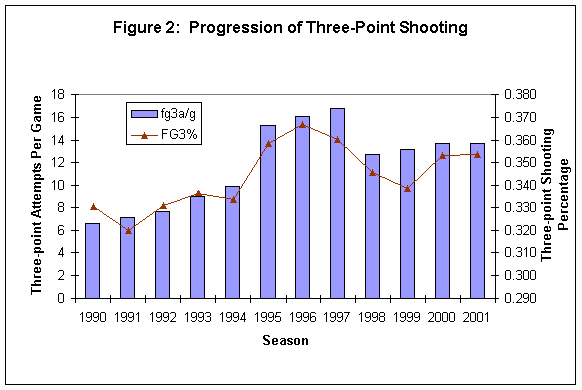
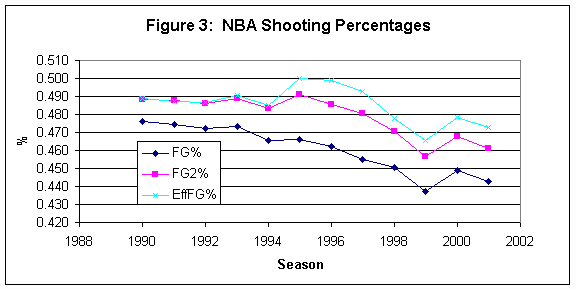
The list of top 10 field goal percentage shooters is almost always populated by big guys who take their shots near the basket. The fact that these guys are shooting worse and worse is an indictment of interior defense. Either it’s gotten better or there are a lot more fouls not being called. Either way, the layups that used to pad some field goal percentages just aren’t happening anymore.
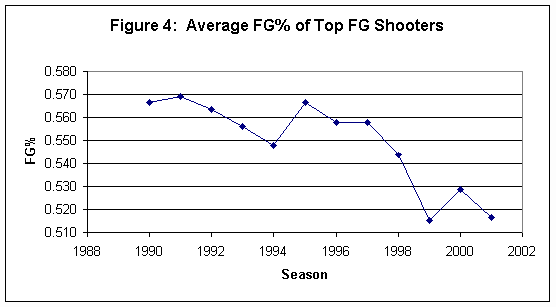
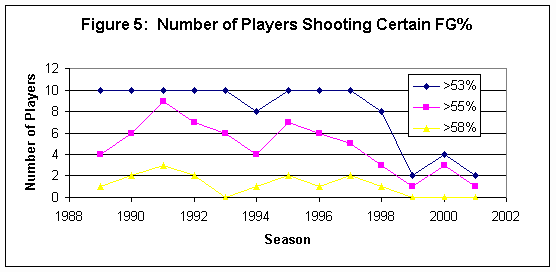
- Coaches implored their troops to get the ball to the best player when they needed a basket and now isolations for top scorers are set up constantly.
The influence of playoff basketball on the regular season helped set up the "No layups" rule, but it also really inspired this strategy, which is what the league seems most concerned about. Isolation-play is not interesting basketball. The motion offenses of the good old days (and of women’s basketball) just don’t exist in the NBA. The only prominent NBA offense that really has a named structure is The Triangle employed by Phil Jackson and, uh, kinda employed by Tim Floyd at the behest of Bulls GM Jerry Krause. Even this offense is set up to create isolation for its best players. Guys get the ball on the low box with good spacing across the court, forcing either an often late double-team, a cutter to the basket (who gets fouled), or a three-point attempt.
Teams are going to their best player for shots now more than ever. It seemed to once be just the Bulls who had a highly imbalanced offense. Now, everyone is doing it. Philadelphia got 28% of its shots from Allen Iverson this year. Detroit got 28% of its shots from Jerry Stackhouse. Orlando and Golden State got 25% of their shots from a single guy. For reference, Jordan took about 27% of the Bulls shots throughout the ‘90’s. The Celtics had 50% of their shots come from 2 players, plus there was the infamous March 7 game where these 2 guys (Paul Pierce and Antoine Walker) scored 66 points on 51 shots and the rest of the starters scored 0 points on 8 shots. That couldn’t have been pretty to watch. Boston justifiably lost.
(If you look at the number of possessions used by individuals relative to their teams, the story is similar. In 1991-1995, the number of teams where one player used more than 20% of his team’s possessions was between 4 and 6. Since 1997, this number has been below 10 only once and has been as high as 15.)
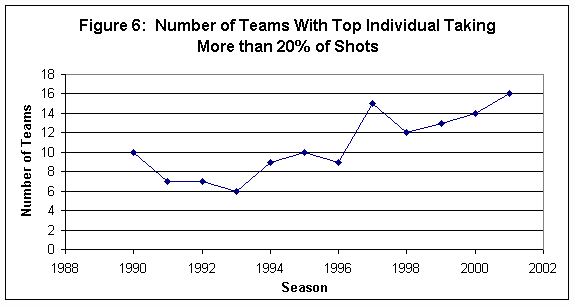
- Coaches yelled at point guards after turning the ball over on a fast break to slow it down, so now they slow it down.
"Slow it down!" is one of a coach’s favorite things to say in an offensive set. It gives a coach time to evaluate a defense, call his own play, and generally be a control freak. This happens at lower levels as much as the NBA now and, as a consequence, so many point guards are now unwilling to lead a fast break for fear of an undressing by their coach.
This is one of the causes of the 6-8% decline in pace over the last ten years. But it may not be a good reason. Turnovers as a percentage of team possessions have stayed steady (or even slightly risen) with the decline in pace, as shown in Figure 7. Assists for the top point guards in the league have fallen 15%, a greater rate than the possession decline. Again, it could be good defense or it could be just less aggressiveness due to the call of "Slow!" from the sideline.
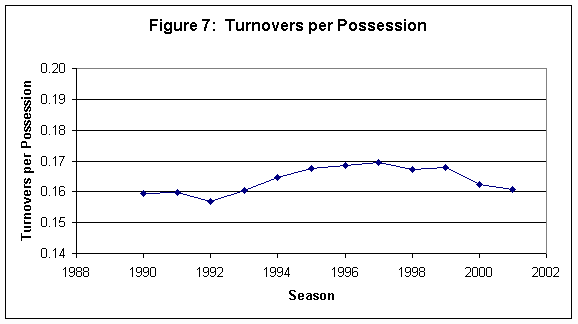
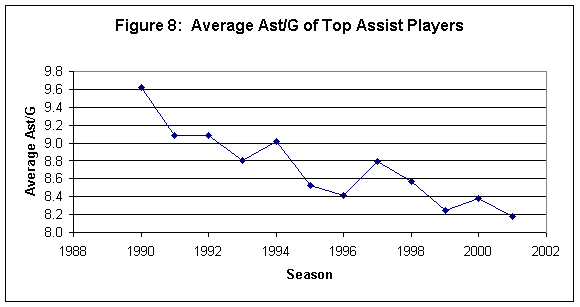
What Will the New Rules Do?
It is admittedly difficult to predict the impact of rule changes, especially the effect of big changes in the long term. Shorter-term effects are a little easier.
For instance, all rule changes but one are immediate aides to the defense, the defensive 3-second rule being the exception. This implies that the initial impacts of the rule changes will be to make the defense even stronger, lowering scoring efficiency. Longer term effects could go the other way – due principally to innovative offensive strategies and player type evolution – but this is harder to predict and is subject to the influence of future rule changes and coaching styles.
The Zone Defense
Teams will only use the rule changes to their advantage when they see the advantage. The big one where they see a potential advantage is the elimination of illegal defense. The league saw this selective adaptation to new rules when they implemented the 3-point line in 1979-80. The teams that initially used it were the ones that had the old ABA 3-point shooting holdovers like Rick Barry, Brian Taylor, and John Roche. It really made only a small improvement in league offensive efficiency because just a few teams took to it.
In contrast, NBA coaches and players are more ready now to make a transition to a zone defense than they were to transition to a 3-point line in 1979. Many NBA coaches have zone experience in their background or have assistants/scouts with that experience. All players with college experience have seen or played in a zone. A zone won’t be as foreign as the 3-point shot was back in the late 1970’s. You can expect to see it used more frequently, though definitely not commonly, in 2001-2002.
We can still use the league history with the 3-point rule to help predict the effects of the zone, despite the above-noted difference. What happened after the first year of the 3-point line in the NBA was a lull in its use. For a couple years, old ABA guys disappeared and it took a while for college kids to come in with the longball mentality. Teams used the 3-pointer somewhat how they will use the zone now – poor teams will be the first to experiment with the new ploy because they weren’t very good with the old ones. Teams will need to stop Shaq and Iverson in order to have a chance and a zone will be used against them. The league’s defensive doormats – Washington, Chicago, and Golden St. – will likely adopt the strategy to protect their poor man defenders and, in Washington’s and Chicago’s cases, to let their young big guys hang out in the lane without getting beat up or picking up fouls too quickly. Mostly, though, teams are going to take advantage of the new rule to slacken their weakside defense out of the man-to-man, allowing quicker double-teams.
Use of the trey was pretty flat until ‘83-84 or so, roughly 3-4 years after the adoption of the rule. Then it started to take off, as college players, who used to stay in school 4 years, came out with the shot, players like Byron Scott and Dale Ellis. Use of the zone is also going to take a few years to be fully implemented (if the rule is not rescinded quickly, which it may be). Teams aren’t going to be innovative about the use of a zone for a couple years, at least. No one is sure how to best implement a zone against the big skilled players of the NBA. In 3-4 years, someone will figure it out, though.
What the league hopes to get with the relaxation of illegal defense rules is a correction to a couple of the things that are wrong with the league. The most direct change it hopes to have is to minimize isolation-play; this should work once NBA teams adopt the zone. But what the league seems to be counting on are some indirect changes.
- By using a zone, teams don’t need the athletic poor shooters who can play man defense, but can hide slower players who can shoot the ball within a zone.
- By having offenses face zones, the league hopes to improve offensive motion against any defense, improving efficiency.
- Zones typically give up both three-point shots and offensive rebounds more readily, things that aid the offense.
Basically, the league wants to improve offense by relaxing defensive rules – a big gamble and one that will take at least 2-3 years to take any effect. It will take this long for teams to stock their lineups with the "zone type" of player. It will take this long for teams to understand how college teams like Duke University so successfully kill a zone by sending offensive rebounders in and hanging shooters on the perimeter. Until this happens, the defense is going to be even stronger than it’s been.
The Defensive Three-Second Rule
The defensive 3-seconds rule basically states that defenders are not allowed to be within the lane for more than 3-seconds without guarding someone closely. The rule has been on the books for years (ironically, as part of Illegal Defense rules) and has been mentioned as an attempt to rectify the "No layups" rule by getting defenders away from the basket. Its ability to do this is highly dubious.
The general impact of the rule on the game is questionable. Coaches aren’t really going to be designing defenses based on it – they haven’t been doing it before, at least. It really depends on how the referees call it. As an example, consider San Antonio against the Lakers. The Spurs will want to have both Duncan and Robinson in the key, perhaps one fronting and one backing Shaq (or at least having another smaller guy on one side or the other). Is that going to be allowed? If it is, it gives defenses a very powerful tool for stopping individual scorers. If not, you’ve just replaced one annoying illegal defense rule with another.
If the league really wanted to cut down on the fouling around the basket, it would have to investigate some other radical rule changes. It might have considered bringing back the 3-to-make-2 for foul shots. It might have considered awarding 3 foul shots for fouls committed within the 3-foot circle. It might have more seriously enforced intentional foul calls. Generally, the league play has gotten more violent within the key and the league office would have been better to address this with a different rule change.
The Eight-Second Halfcourt Rule
This rule change has not been discussed much, implying that its effect on the game is going to be delayed. The intent is to speed up the game, meakly trying to legislate against coaches who yell "Slow" from the sideline and more strongly trying to encourage full court pressure defense.
Where this has potential is in combination with a zone defense. A full court zone press may actually have some effect on point guards given a shorter period to cross halfcourt. There is no hint that this strategy will be used extensively right away. NBA teams are so unaccustomed to running such a defense that they won’t know how to do it without giving up a lot of layups – and the "No layup" rule means one layup is too many. It will likely take a couple years for an assistant coach somewhere to draft up a good defensive set that is more than a modified man-press. It could take more for coaches to accept that giving up an occasional layup is OK in return for efficient defense.
Long-term, this rule is not a bad one. It’s fairly innocuous, but eliminates the walk-it-up approach that allows coaches to talk to their point guards while approaching the offensive set. It will start to even out the odds so that fullcourt defenses have a chance to work against the good ball-handlers of the NBA and encourage fast breaks as a rebuttal strategy.
The Relaxation of Hand-Checking Rule
It’s not clear that the original tighter hand-checking rules made that big a difference in coaches’ strategic thinking. It’s equally unclear whether the relaxation of the rules is going to make a difference. Most likely, the hand-checking rule only changes the annoyance factor with inconsistent referee calls, which was its goal.
Summary
The league has been facing a number of problems in the last ten years that it is addressing with new rules for next year. The slow and predictable offensive styles of recent years have come out of strategic moves by coaches who know how to take advantage of the rules. The biggest thing has probably been isolation play, which takes full advantage of a required man defense. By allowing zones next year, the NBA intends to reduce the amount of isolation play and make offense more of a team game. In this way, the rule changes appear quite beneficial.
But by allowing a lot of defensive freedom, the NBA is really accentuating the improvement of defenses observed in the last ten years. The quick defenders will still be around and so will the tight man defenses. The zones will be used lightly and primarily when they give a team another defensive benefit. The pace of the game will likely continue to be slow or even slower, at least for several years until different personnel enter the league and/or the 8-second halfcourt rule plays a bigger role.
Longterm effects of the changes may be beneficial – if the league indeed allows the changes to exist for several years. (I don’t believe the league has openly committed several years to making the rules work. Unless that commitment is there, initial problems in adapting to rules could scare officials into rescinding them.) After several years, "zone type" personnel who can shoot and may have less mobility will enter the league, making offense stronger and defense weaker. Teams may try to push the ball upcourt to prevent a zone from getting set, but this seems very unlikely until zones are actually used more extensively.
It is not clear how the defensive 3-second rule will be called. If it becomes just another annoying illegal defense call when double-teaming a scorer down low, it may neutralize some of the variety encouraged by the zone rules.
Finally, it appears that one of the NBA’s biggest problems is the decline of the layup due to the "No layup" rule used by many coaches. This already limits off-the-ball cuts to the basket and fast breaks because players are much more likely to get fouled hard and, as a natural consequence, to miss more layups (either from fear or from increased missed calls). None of the rule changes appears to address this problem.







